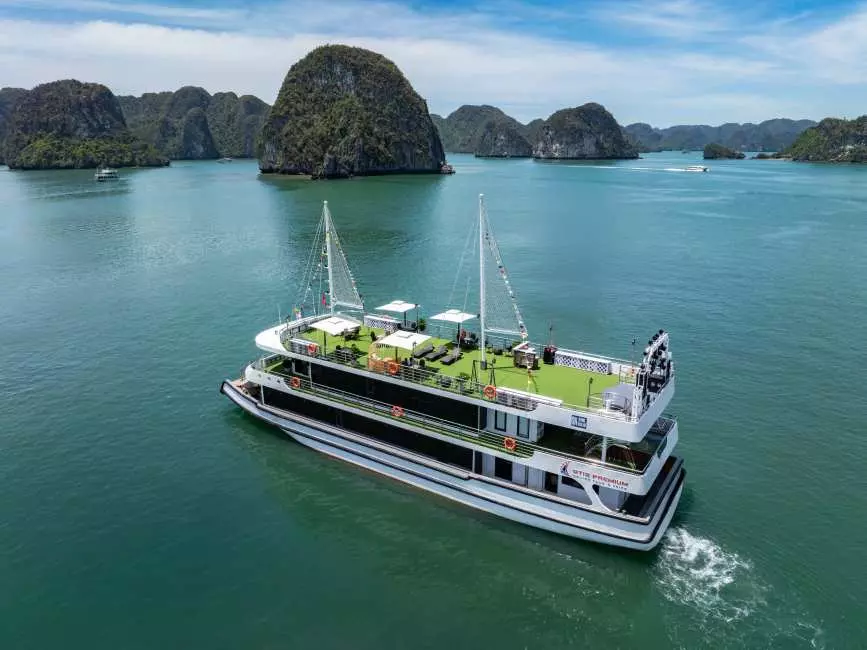Each year between mid-March and July these slow-moving, gentle, filter-feeding giants migrate past Ningaloo Reef. The world’s biggest fish can grow to lengths of 12 metres or more and has a healthy appetite in order to sustain its immense size. Fortunately for most sea-dwellers (and for us) they feed primarily on plankton and krill, taking in huge gulps of water and filtering out their microscopic meal.
Far flung and exclusive, yet teeming with creature comforts, Sal Salis is a well-kept, off-grid secret in the Western Australian coastal wilderness. Follow our itinerary to meet the largest fish in the world, while luxuriating in this true eco retreat.
Day 1
Board a two-hour Qantas flight from Perth to Learmonth Airport (Ed’s note: it’s the only carrier), ideally arriving early afternoon. The tarmac lies just out of Exmouth, the town at the tip of the peninsula that points to the World Heritage-Listed Ningaloo Coast. Within its streets, emus have right of way, an indicator of both the eco-friendliness and character in these parts. You could hire a car, but trust us, once you arrive at Sal Salis, you won’t want to go anywhere. Instead, allow the team to whisk you from the airport to the dune-nestled site (it’s a 90-minute drive)or, better yet, take a scenic flight over Cape Range National Park and Ningaloo Reef, setting the tone for this secluded getaway.

A bird’s-eye view of Sal Salis overlooking the fringing coral reef.
Arrive in time to stroll along textured sand – the reef is so close, at low tide you’ll spot coral and fish with only your ankles in the water. You might even be tempted to don a snorkel and mask; different creatures emerge as the day becomes long.
By sunset, clink glasses and munch canapes at the recently rebuilt communal lodge, meeting other guests with whom you’ll later share a lantern-lit three-course dinner. Bed is only steps away: follow discreet, solar boardwalk lighting to your luxe safari tent.
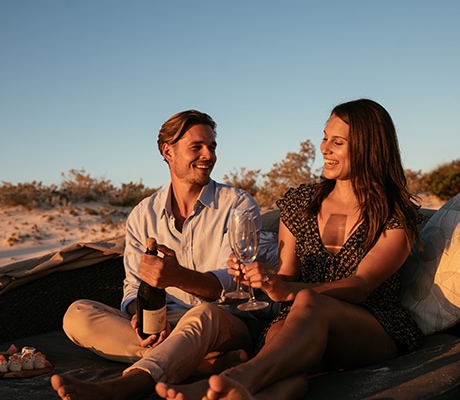
Enjoy sunset drinks looking out over the reef.
Day 2
Wake to the harmony of native birdsong and the gentle scratch of wallaby paws on your front deck. The marsupials often visit at daybreak to nibble on the surrounding vegetation.
Today, you’ll come face to face with a whale shark, joining a day-trip charter boat (cost additional; from $509 per person) as it combs the Indian Ocean for these gentle giants, in tandem with spotter-planes overhead. The harmless creatures have a soft spot for Ningaloo; an estimated 300 to 500 whale sharks cluster there each year. Coasting just beneath the surface, the whale sharks hoover up plankton with their vacuum-like mouths. They generally arrive in March and stay until August, making way for the 40,000-strong humpback migration along Western Australia’s coastline.
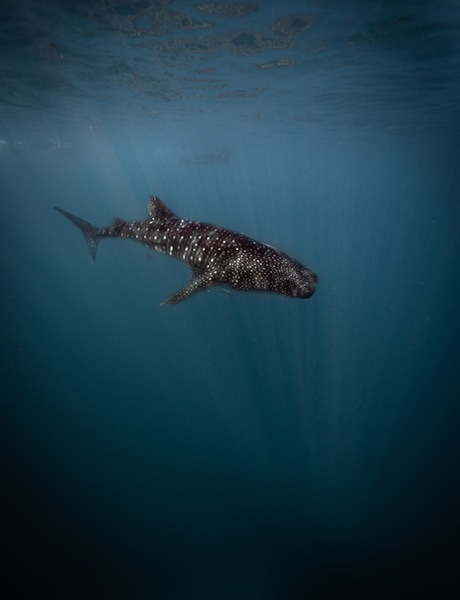
Swim alongside majestic whale sharks.
Onboard, snorkel gear, wetsuits and lifejackets are provided, along with enormous enthusiasm for the experience ahead. Be prepared for rapid water entry and expect to be so dumbfounded when you eyeball a whale shark that you’ll forget to swim alongside it. Paddle madly to catch up and then enjoy its fluid movements as you freestyle beside it.
Returning to Sal Salis – hopefully having also ticked off a manta ray sighting – you’ll wash the salt away with a three-minute eco-shower. Each tent is allocated 20 litres of water per person, per day, to minimise the camp’s environmental footprint. Use the organic shampoo and native herb soap supplied to support the retreat’s eco-ethos. Later, fall into air-dried, organic cotton sheets and sleep soundly knowing five per cent of turnover goes towards the WA government’s conservation work in the Cape Range National Park.
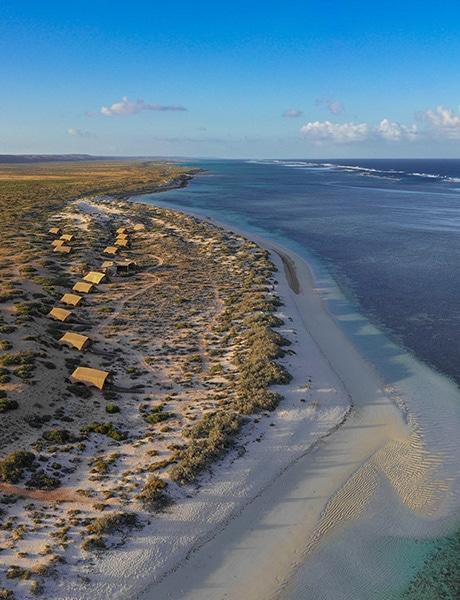
Sal Salis is located in a patch of WA paradise.
Day 3
Today is all about the luxury of doing little. With wi-fi and phone reception deliciously absent, grab a book from the lodge library and swing in your tent’s hammock as the breeze tickles your toes. As the day warms, take a slow float over the healthy reef’s delights: more than 500 species of colourful fish dart between 250 coral species, while turtles and rays roam the shallows. Sal Salis has snorkelling gear on hand, and guides happily offer lessons and advice. It’s remarkable to wade only metres into the ocean before reaching the fringing reef – no boat is required.
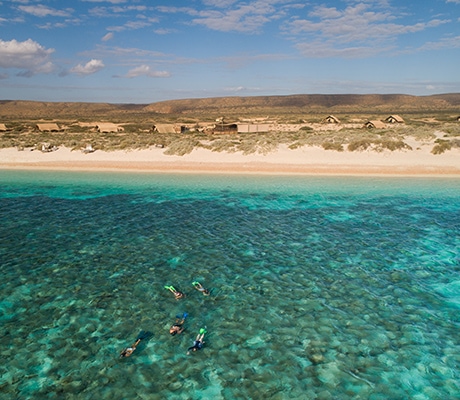
Sal Salis has snorkelling gear on hand, and guides happily offer lessons and advice.
After a long, lazy lunch of the resident chef’s seasonal fare, top up your glass from the self-serve bar and pull out a board game. That and a bit more hammock time – or maybe a guided hike, or kayak jaunt – will get you through to sunset drinks and then, another convivial, multi-course dinner.

Enjoy first-class food and wine.
As you float to bed, look up: the night sky’s billions of stars are astonishingly radiant. Unobstructed by ambient light, the Milky Way beams with a clarity unseen in most parts of the world, leading the region to be declared a designated Dark Sky area. In April 2023, Sal Salis is in the path of a total solar eclipse, providing yet another reason to plan a trip.
Day 4
As you wake to honey-hued scrub warmed by the rising sun, you’ll (only half) jokingly suggest selling the house so you can stay permanently. Pad down to the beach for a reviving morning swim, chased with your final open-air breakfast on the lodge deck.
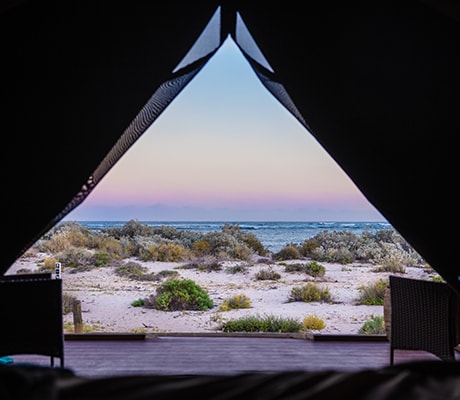
The dreamy view at sunrise;.
Leaving this dreamy destination will be heart-wrenching (we know firsthand), but with guest numbers strictly limited and the environment so carefully protected, you’ll find solace in the knowledge that it will be here for years to come.
Visit salsalis.com.au
